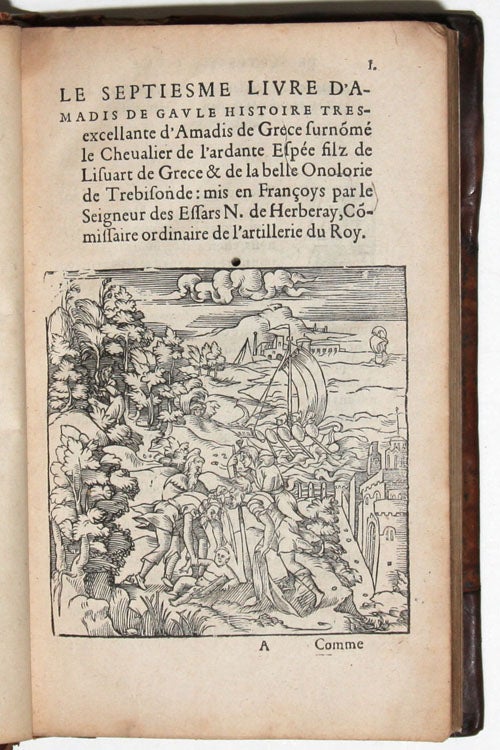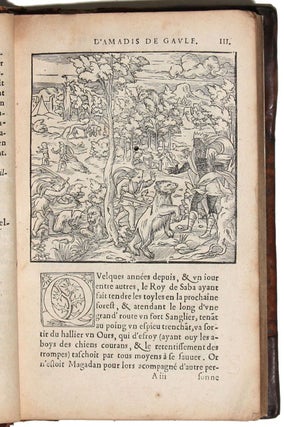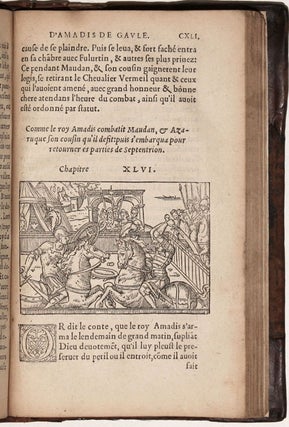Le Septiesme Livre d’Amadis de Gaule, mis en Francoys par le Seigneur des Essars Nicolas de Herberay.
8vo. [17.1 x 10.2 cm], [8] ff., CXCII ff., with title woodcut, 2 three-quarter page, and 17 quarter-page woodcut illustrations. Bound in old calf rebacked, with red morocco title on spine and renewed calf corners. Title slightly frayed, tiny wormhole continues throughout text not affecting legibility; occasional light foxing to margin of some leaves. Internally, unwashed & genuine.
Extremely rare French edition of the seventh installment of Amadis de Gaule’s adventures, the most popular chivalric romance of 16th-century Europe. De Herberay’s translations have been hailed as an “acte fondateur” in the development of French prose (Chatelain). The tales of Amadis de Gaula, of supposed Iberian origin, enthralled audiences across two continents from Spanish conquistadors to German sequel-writers, eventually running to no less than 24 installments.
De Herberay’s translations were revolutionary on many counts: as Chatelain points out, it was the elegant design of his books as much as their prose which truly manifested an “esprit nouveau” in the history of French literature. Along with his delicate, Fontainbleau-inspired woodcuts, the printer Estienne Groulleau retained in the present work the clear format and “lisibilité parfaite” of the original editions including single-column text and roman type instead of gothic. However, the smaller format of the present volume probably reflected the increasing popularity of the genre and the need for a low-cost, accessible edition. Indeed, in Germany and England Amadis was known chiefly through French translations like the present work.
The first printed Amadis de Gaula was a Spanish creation by Garci Rodríguez de Montalvo in 1508. By the time Nicolas de Herberay introduced the hero into the French vernacular (the second to appear after Portuguese) in 1540, he had become popular enough to rival Pantagruel:
“it is remarkable that just at the time when Rabelais published the second and best book of his Pantagruel, in which the ideality and realism of the Renaissance blossom to the full, there was a certain revival of the chivalric romance…The gallant achievements of courtly knights, their mystical and platonic loves, were a delight to Francis I, and charmed a whole generation.” (Dowden, A History of French Literature)
Although the subsequent swathe of sequels prompted Cervantes to satirize the ‘knight-errant’ genre in Don Quixote (whose idol is Amadis), Quixote’s barber proclaims the original Amadis de Gaula the “best of its kind”. The present work - as the French editions did not follow the Spanish divisions exactly - actually represents part of the Spanish Book IX, one of the numerous sequels produced by Feliciano de Silva to quench popular demand. It includes, like all the tales of Amadis, a gross abundance of star-crossed lovers, damsels in distress, knights-errant, and illegitimate children. The present volume specifically recounts the adventures of love and intrigue which Lisuarte and Perion, grandsons of Amadis, suffer from Greece to Ireland, including encounters with ape-men and giantesses.
De Herberay’s translation of the Septiesme Livre first appeared in a folio format in 1546. A number of other editions appeared throughout the 16th century in various formats: all are extremely rare in census. Of any 16th century edition, OCLC lists just one US copy of the 1546 edition at Berkeley, and one copy of the present edition at Illinois. It is not identical, however, having been sold by Vincent Sertenas rather than Jean Longis, a fact reflected on its title page. Both ,libraires had a long-standing agreement with de Herberay and Janot and were the sole vendors of these French translations in their early years.
* Jean-Marc Chatelain, “L’illustration de’Amadis de Gaule dans les éditions françaises du XVIe siècle” in Cahiers V. L. Saulnier, Les Amadis en France au XVIe siècle (2000); Dowden, A History of French Literature (2004); Coward, A History of French Literature (2002)
Price: $3,300.00



